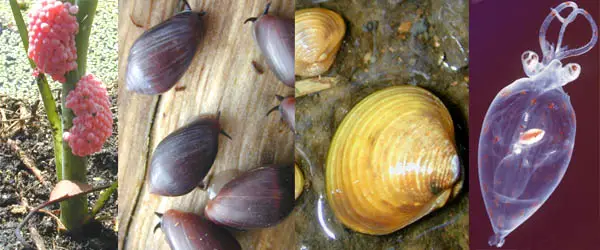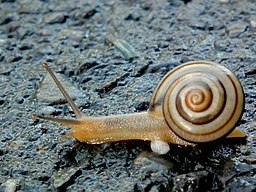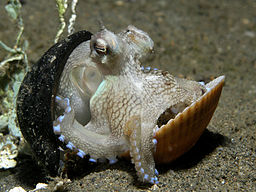Phylum Mollusca
** Examples and Characteristics
With about 100,000 described species, the phylum Mollusca is one of the most predominant groups in marine environments and the second largest phylum in the Animal Kingdom (after Arthropoda). However, they can also be found in terrestrial and freshwater environments.
The wide variety of organisms (of varying forms) are divided into seven (7) main classes in phylum Mollusca that include:
· Aplacophora (E.g. Neomenia yamamotoi and Chaetoderma elegans)
· Bivalvia (E.g. Oysters, Mussels, and Clams)
· Monoplacophora (E.g. Micropilina arntzi)
· Polyplacophora (E.g. Chitons)
· Cephalopoda (E.g. Squids and octopuses)
· Gastropoda (E.g. Snails and slugs)
· Scaphopoda (E.g. Tusk shells)
Characteristics
Anatomy (Morphology)
Generally, members of the phylum Mollusca are coelomate, bilaterally symmetrical organisms that consist of several body regions including the head, a foot mantle, and a visceral mass. They also display high diversity in form (their size and body structure) with some of the organisms developing an asymmetrical characteristic over time.
This section will focus on the body plan of four of the most common groups:
Gastropoda
Snails and slugs are some of the most common members of the class Gastropoda known as gastropods.
Head - Slugs and snails have a distinct head with tentacles (and eyes at the terminal end). Apart from the tentacles, it's also possible to identify the mouth (with rows of chitinous teeth). The head also houses the cerebral ganglia and a salivary duct.
Visceral mass - The visceral mass makes up the body part of the organism. Located posterior to the head, the visceral mass resembles a hump above the foot region. It's covered by a mantle and houses a number of important organs including the liver, lung, digestive tract, genital pore, reproductive organs, and stomach among others. Depending on the organism, the mantle and visceral mass may be enclosed in a shell (e.g. snails have a shell while slugs do not).
Foot - Gastropods have a muscular ventral foot which is broad and flattened. In some of the species, the foot consists of the operculum (hardened flap) on its posterior end.
* The word "Gastropod" means stomach-foot.
* Some of the other members of the class Gastropoda include nudibranchs, limpets, abalones, and whelks.
Bivalvia
Some of the animals within the class Bivalvia include oysters, clams, scallops, and mussels.
Head - Unlike gastropods which have a clearly distinct head, Bivalvia species have a poorly developed head region.
Body - As the name suggests, the body is enclosed in a pair of shells (valves) which are hinged at the dorsal end by shell ligaments. The hinge also consists of a series of teeth that align the two shells. Typically, the two valves are lined by a mantle (a specialized tissue) which is responsible for the production of material that enlarges the shell.
Here, these materials are secreted and added at the free edge of the shell which allows it to enlarge over time. Inside the shells, the soft body of the bivalves consists of a muscular foot, gills/ctenidia, a digestive system, heart (three-chambered heart), stomach, and nerves.
Cephalopoda
Some members of the class Cephalopoda include octopods, squids, cuttlefish, and nautilus, etc.
Head - While the name cephalopods means "head-foot" where muscular tentacles extend from the head, members of this class have a well-developed defined head that bears large eyes and a mouth. Like some of the other members of the phylum Mollusca, cephalopods have a small radula. However, it's not used for capturing food.
In addition to the radula, squids and some of the other members of the class have a beak-like jaw (resembling a parrot beak) which allows them to bite off and swallow chunks of the prey. According to studies, members of this class also have one of the most complex brains compared to other invertebrates.
* The head is located between the visceral mass and the modified foot (tentacles).
Visceral mass - The visceral mass is located posterior to the head region. The visceral mass is contained within the mantle which is in turn covered by a shell in some of the species. Within the visceral mass is a stomach and other parts of the digestive system, reproductive organs, gill, part of the circulatory system (closed), the heart, and ganglia around the esophagus.
Foot - In cephalopods, the foot is modified into tentacles (arms) that extend from the head. These tentacles are used to capture prey.
Polyplacophora
The word Polyplacophora means "bearing many plates". Chitons, which are snail-like organisms, are the most common members of this class in phylum Mollusca.
Head - Like some of the other mollusks, chitons have a head. However, they do not have eyes and tentacles. Here, some of the parts that can be easily identified include the mouth, radula (with 17 teeth), and esophagus.
Visceral mass - The dorsoventrally flattened body is covered with a shell (divided into a series of eight calcareous pieces) behind the head. The mantle contains a number of organs including the heart, stomach, intestine, coelom, gill, nephridium, and the reproductive organs.
Foot - They have a muscular foot that contracts to produce waves during movement.
Phylum Mollusca Habitat/Distribution
The phylum Mollusca consists of a wide variety of animals that distributed throughout the globe. They can be found in marine and freshwater environments while others can be found in some terrestrial habitats. Freshwater mollusks are commonly found in lakes and streams etc. and include members of the class Gastropoda (E.g. limpets and snails) and some Bivalves like mussels.
The majority of species, however, can be found in marine habitats (shallow coastal habitats to deep waters). For instance, caudofoveates can be found on the seafloor where they reside in burrows. Chitons, on the other hand, are commonly found along the rocky coastlines throughout the world.
While members of some classes are only found in specific environments, others can be found in different environments where they reside in different habitats. For instance, gastropods and bivalves can be found in marine, freshwater, and terrestrial habitats.
Though mollusks can be found in different types of environments, they are commonly found in habitats that are suitable to their respective needs. In the case of some species found in freshwater, studies have shown them to reside in habitats with sufficient calcium concentration for shell construction.
Some of other factors that influence the type of species found in specific habitats include temperature (e.g. some gastropods can survive extreme temperature variations while the increase in mean temperature influence increased snail growth and early reproduction), nutrition, and oxygen concentration (e.g. as compared to caenogastropods, pulmonates (snails) can tolerate variations in dissolved oxygen)
* Exclusively aquatic mollusks use gills for respiration while some of those found in terrestrial habitats (e.g. pulmonates) use a lung for breathing.
* Gastropods make up about 80 percent of all mollusks (with over 65,000 species). They can be found in marine, freshwater, and terrestrial habitats.
Different types of mollusks are also well adapted to survive in their respective habitats.
The following are some of the adaptations associated with their lifestyle:
Burrowing mollusks - Burrowing mollusks can make burrows in soft sediments. To achieve this, they can use shell hinge teeth, a large foot, or short siphons. Some of the most common burrowing mollusks include cockles, gapers, peppery furrow shell, and Pitar lupanaria.
When burrowing, mollusks like cockles push their foot into the sand and wiggles the foot in order to make the sand softer. Blood is then forced to the foot causing the tip to swell and act as the anchor. This allows the shell to be rocked back and forth into the sand.
As the shell moves back and forth, the organism squirts little jets of water around the shell making it easier to dig and enter the burrow.
* The foot used for forming burrows is also used for locomotion.
Freely swimming mollusks - Some marine and freshwater mollusks are capable of freely swimming. Some of the most popular swimmers are members of the class Cephalopoda (E.g. squid). Unlike some of the other mollusks, cephalopods like squid and cuttlefish are equipped with fin-like structures, known as undulating fins, that make swimming possible.
In addition to the fin, squids also make use of a pulsatile jet and tentacles for stability. Some of the other freely swimming mollusks include the Sea angel, Sea butterfly, and Limacina species.
Crawling mollusks - Crawling mollusks include species that can be found in marine, freshwater, or terrestrial habitats. Unlike some of the bivalves that use a foot to drag their body on sand, crawling mollusks like snails and slugs have an elongated muscular foot used for crawling.
Here, contraction and relaxation of the muscular foot allow the organism to crawl over a layer of slime and move in a given direction. Using this method, these mollusks can crawl on different types of surfaces on land and in aquatic habitats.
* Some of the other characteristics associated with mollusks include: attachment to the substrate (e.g. Spondylus and Oysters) nesting (e.g. some File shell), and symbiotic relationships with other organisms (e.g. symbiosis between giant clams and dinoflagellates)
Reproduction
With the exception of some snails (which are hermaphrodites), the majority of mollusks are dioecious (male and female individuals). As well, some of the organisms in this phylum (e.g. Oysters) have been shown to change their sex several times over the course of their lives.
Sexual reproduction among hermaphrodites - Freshwater snails are among the most common hermaphroditic mollusks with the ability to self-fertilize. However, many species can accept and store sperm from many other individuals. During reproduction, the sperm cells and eggs are produced in the ovotestis and released through the hermaphroditic duct.
Proteins and nutrients from the albumen gland are added to the egg as it passes through the duct before being fertilized by sperm cells from the same individual or another individual.
Following fertilization, the external egg membrane is secreted in the oviduct and the eggs eventually laid in gelatinous cases attached to plant or rock surfaces.
Sexual reproduction among dioecious species - Caenogastropods are examples of dioecious mollusk animals. While there are separate male and female individuals, different species have been shown to use different organs to deposit sperm cells. For instance, whereas viviparids use an enlarged right tentacle as the copulatory organ, valvatids and hydrobiids have a specialized penis/verge.
As well, thiarids and pleurocerids lack a copulatory organ. During reproduction, females release their eggs into the coelomic cavity so that they can be carried out of the body through the appropriate ducts (males also release sperm cells into the coelomic cavity before it's carried out through the ducts). The eggs are therefore fertilized externally to produce zygotes that develop into gastrula.
Under favorable environmental conditions, the gastrula gives rise to free-swimming trochopore larva which develops into a planktonic larva (veliger). This type of larva is characterized by a well-developed foot and shell among other structures that contribute to their survival.
For most species, the larva settles at the bottom of the water body where they undergo metamorphosis and mature to produce adult forms.
* Some mollusks like pill clams undergo direct development and therefore skip the larval phase.
* While many snails are hermaphrodites, cross-fertilization is usually preferred. Here, studies have shown the amount of sperm cells stored to be the main determining factor of whether the snail acts like a male or a female.
Nutrition
Members of the phylum Mollusca can be found in different habitats where they feed on a variety of food sources. Snails and slugs, which are some of the most common mollusks, feed on plants, animal waste, other snails and decaying organic matter, etc.
For this reason, they may be described as both omnivorous and detritivorous. This feeding behavior is made possible by a flexible set of microscopic teeth (thousands of teeth) known as the radula. In some of the species (e.g. Whelks), the radula can extend beyond the shell and even burrow through the shell of other mollusks (eating them in the process).
Filter feeders (e.g. bivalves) mostly feed on suspended matter in their surrounding. Generally, the process involves passing water over the gills. This allows food particles to be trapped for consumption.
For larger and more developed species like members of the class Cephalopoda, the jaw and tentacles are used for the purposes of hunting and capturing prey. Because they are highly mobile, they can strike quickly to capture smaller mollusks and other animals like crayfish and crabs as a source of food.
* Some of the mollusks are classified as grazers and survive by feeding on algae (microscopic and filamentous algae) and various plants in their surroundings.
Circulatory System
The majority of mollusks have an open circulatory system. Here, blood is not entirely contained in blood vessels. Rather, it also passes through the primary body cavity (hemocoel) and into the tissues before returning to the vessels. In this type of circulatory system, the heart pumps blood through blood vessels to the hemocoel.
From this cavity, the blood reaches internal body organs allowing for gaseous exchange . Oxygen is transported to the organs while carbon dioxide is taken up. From the hemocoel, blood enters the blood vessels and is transported to the gills where carbon dioxide is released and oxygen received. From the gills, oxygenated blood is transported to the heart where it's again pumped.
* Members of the subclass Coleoidea, in the class Cephalopoda, are the only mollusks with a closed circulatory system. Here, some of the most common species include squids and octopuses.
The blood is pumped into the blood vessels by three hearts (a systemic heart and two additional branchial hearts) and gaseous exchange occurs at the gills.
Nervous System
With the exception of cephalopods, the majority of mollusks do not have a brain. However, they have a nervous system where the nerve cells are concentrated in a ganglia (knots of nerves) in different parts of the body, particularly the head, mouth, and other sense organs.
These ganglia are connected by several pairs of nerve cords including two pairs of longitudinal nerve cords, one pair of lateral nerve cords, and a ventral pair of pedal nerve cords.
Compared to other mollusks, cephalopods have a more developed nervous system. This consists of a small brain and clusters of neurons in other parts of the body including the arms.
* The nerve cells of mollusks do not have myelin sheath. In Cephalopods, however, studies have shown these cells to develop giant axons.
See also:
Coelomates, Acoelomates and Pseudocoelomates
What does Phylum mean in Biology?
Return from Phylum Mollusca to MicroscopeMaster home
References
Mark Pyron and Kenneth M. Brown. (2015). Introduction to Mollusca and the Class Gastropoda.
Roger P Croll. (2009). Developing Nervous Systems in Molluscs: Navigating the Twists and Turns of a Complex Life Cycle.
Saxena, A. (2005). Text Book of Mollusca.
Yan Wang and Clifton W. Ragsdale. (2019). Cephalopod Nervous System Organization.
Links
https://www.sciencedirect.com/topics/agricultural-and-biological-sciences/polyplacophora
https://manoa.hawaii.edu/exploringourfluidearth/biological/invertebrates/phylum-mollusca
Find out how to advertise on MicroscopeMaster!







